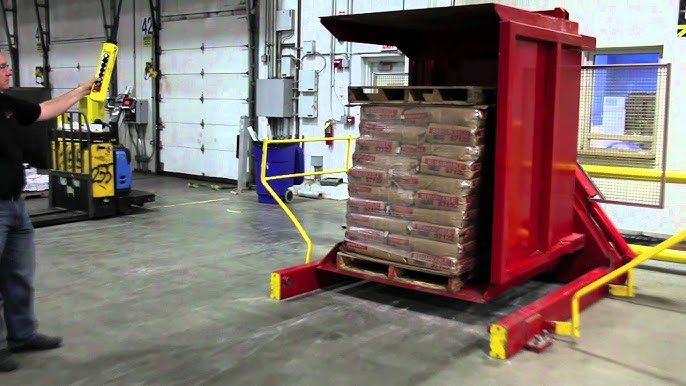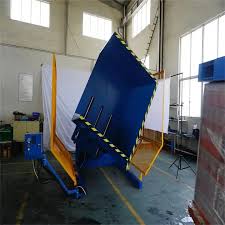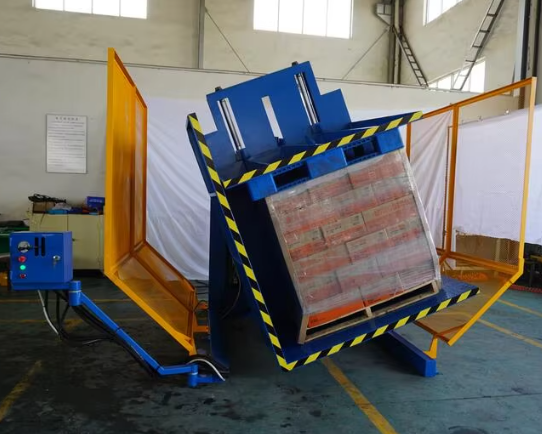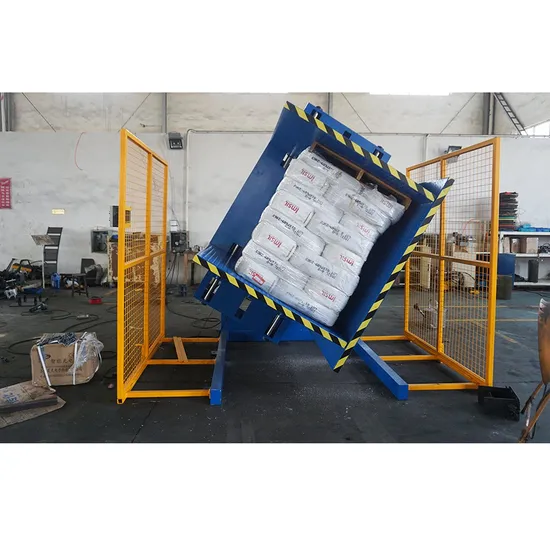What’s the ROI of Automated Pallet Changing Machines in Mexico's border Sector?
Running a steel mill in Mexico's bustling border sector is a constant balancing act. You're fighting against volatile energy costs, aging machinery, and increasing pressure to be both more productive and more environmentally friendly. You know that every piece of equipment must justify its existence with a solid return on investment. The manual processes at the end of your production line, like changing pallets for shipping, might seem like a minor detail, but they are often a source of hidden costs, delays, and inefficiencies that eat away at your profit margins. You might be wondering if automating this one step is really worth the capital expense.
The return on investment (ROI) for an automated pallet changing machine in Mexico's steel sector is typically realized within 12 to 24 months. This rapid payback comes from significant reductions in labor costs, a drastic drop in product damage during handling, increased operational speed, and improved safety. For a high-capacity steel mill, these efficiencies translate directly into lower operational expenditures and higher throughput, making it a financially sound strategic investment.

I understand the pressure you're under. I've been on the factory floor, and I've also been the one signing the checks for new equipment. The decision to invest in new technology is never easy. It requires a deep dive into the numbers and a clear understanding of the real-world impact. In this article, I want to walk you through the key factors that determine the ROI of these machines, drawing from my own experience as an engineer and a factory owner. We will look beyond the price tag and explore how this technology directly addresses the core challenges you face every day.
How Can Pallet Changers Directly Tackle Rising Operational Costs in Mexican Steel Mills?
You see the numbers every month. Energy prices fluctuate, labor costs creep up, and every damaged product is a direct hit to your bottom line. It feels like a constant battle to keep operational costs under control. You've likely optimized the big things, like your furnace and rolling lines. But the "small" costs in your logistics chain add up. Manual pallet handling requires multiple workers, expensive forklift operations, and always carries the risk of human error, leading to damaged goods that must be reworked or scrapped. This is a slow, costly, and inefficient drain on your resources.
Automated pallet changers directly attack these operational costs by replacing expensive manual labor with a reliable, one-time capital investment. They drastically reduce product damage, often by over 95%, by ensuring a smooth and secure transfer process. Furthermore, they cut down on forklift usage—and the associated fuel, maintenance, and operator costs—by creating a centralized, efficient transfer point. This transforms a cost center into a streamlined, predictable part of your operation.

Dive Deeper: Breaking Down the Cost Savings
Let's get specific and analyze how these savings accumulate. An investment decision for someone like you, Javier, isn't about vague promises; it's about hard numbers. We need to dissect the operational costs of manual pallet changing and compare them directly to an automated system.
Labor and Safety Costs
A manual pallet exchange process for heavy materials like steel coils or wire often requires two, sometimes three, workers to ensure it's done safely. They need to coordinate with a forklift driver. This is slow and carries a high risk of injury. Back strains, crush injuries—these are real dangers that lead to lost workdays, higher insurance premiums, and potential legal issues. An automated pallet changer, on the other hand, requires only one operator, often the forklift driver themselves, to initiate a cycle that completes in under 60 seconds.
Equipment and Energy Costs
Think about the journey of a forklift in a manual system. It picks up the load, transports it to a staging area, sets it down. Workers then manually re-stack the product onto a new pallet. The forklift then returns to pick up the newly palletized load. This involves significant travel distance, fuel consumption (or battery usage), and wear and tear on the forklift. An automated system creates a fixed point for exchanges. The forklift simply places the pallet in the machine and picks up the new one moments later. This reduction in "forklift miles" directly addresses your goal of lowering energy consumption.
Product Damage Costs
This is one of the biggest hidden costs. When workers manually handle heavy steel products, the risk of dropping a coil, denting a stack of sheets, or scraping a finished product is high. Each damaged item represents lost material, lost labor, and lost production time. An automated pallet changer uses a gentle and secure clamping or tilting mechanism, handling the entire load as a single, stable unit. The process is repeatable and reliable, virtually eliminating handling-related damage.
Here’s a clear comparison:
| Cost Factor | Manual Pallet Changing | Automated Pallet Changing |
|---|---|---|
| Labor Requirement | 2-3 Workers + 1 Forklift Operator | 1 Forklift Operator |
| Cycle Time | 5-10 minutes | < 1 minute |
| Product Damage Rate | 1-3% (or higher) | < 0.1% |
| Safety Risk | High (strains, crush injuries) | Very Low (operator is clear of moving parts) |
| Forklift Usage | High (multiple movements per pallet) | Low (one drop-off, one pick-up) |
| Energy Consumption | High (forklift fuel/electricity) | Low (efficient machine cycle) |
My Insights
Here’s my take as an engineer and factory owner. When I first started my own factory, I watched every single peso. I remember tracking my forklift fuel consumption and being shocked at how much we spent just moving things around internally. The numbers on a spreadsheet are one thing, but seeing the real-world difference in your monthly P&L is what truly convinces you. Automating our pallet changing was one of the first major upgrades I made. The ROI wasn't just about saving on labor; it was about reducing product damage claims from customers and cutting my fuel budget. It simplifies a chaotic process and gives you back control over your costs.
How Does Automation Mitigate Risks from Aging Equipment and Labor Shortages?
Your facility has equipment that has served you well for over 15 years. But you know that older machinery brings uncertainty. The risk of unexpected breakdowns is always there, and a single failure in the logistics chain can bring your entire multi-million dollar production line to a halt. On top of that, finding and retaining skilled, reliable workers for physically demanding jobs is a growing challenge in Mexico and everywhere else. You're caught between the unpredictability of old equipment and the unpredictability of the labor market.
Automation acts as a powerful buffer against these risks. A new, automated pallet changer introduces a highly reliable, low-maintenance system into your workflow. With predictable performance and scheduled maintenance, it eliminates the unplanned downtime that plagues aging equipment. It also directly addresses labor shortages by taking over a repetitive, physically demanding task. This frees up your valuable human workforce to focus on more complex, value-added roles where their skills are truly needed, rather than on manual labor.

Dive Deeper: Building a More Resilient Operation
A resilient operation is one that can withstand shocks, whether from a machine failure or a staffing issue. For a CEO like Javier, building resilience is just as important as driving efficiency. Let's examine how automation contributes to a more robust and predictable factory floor.
Uptime and Reliability
Modern automated equipment is designed for high-cycle, 24/7 operations. Key metrics like Mean Time Between Failures (MTBF) for a new pallet changer are measured in thousands of hours, far exceeding that of older, general-purpose logistics equipment.
- Predictive Maintenance: New machines come equipped with sensors that can monitor performance and signal when maintenance is needed, aligning perfectly with your goal of predictive maintenance. You can service the machine during planned downtime, not in the middle of a critical production run.
- Reduced Dependencies: Your end-of-line logistics are no longer dependent on a specific forklift that might be due for service or an employee who might call in sick. The automated system is a constant, ready to perform its task whenever needed.
Human Capital Optimization
The term "automation" often brings fears of job replacement. But in my experience, it's about job elevation. In a tight labor market, you can't afford to have your skilled workers doing tasks a machine could do better.
- Focus on Value: By automating the pallet exchange, you allow your team to focus on quality control, machine oversight, and problem-solving. You are not replacing people; you are upgrading their roles.
- Improved Safety and Morale: Removing one of the most physically strenuous tasks from the factory floor has a direct impact on employee morale and safety. A safer workplace is a more productive workplace. This reduces turnover, a significant cost for any business.
Here’s a breakdown of how automation mitigates operational risks:
| Risk Category | In a Manual System | With an Automated System |
|---|---|---|
| Equipment Downtime | High risk due to aging forklifts or other handling gear. Unpredictable failures. | Very low risk. High MTBF. Enables predictive maintenance. |
| Labor Availability | Dependent on staff showing up. Risk of halt due to sick leave or turnover. | Not dependent on specific individuals. Consistent operation. |
| Process Consistency | Varies by worker, shift, and fatigue level. Inconsistent handling. | Perfectly consistent. Every cycle is identical. |
| Safety Incidents | High risk of manual handling injuries, leading to downtime and costs. | Minimal risk. Operator is removed from the process. |
My Insights
I started my career as an engineer on the floor. I've seen a production line stop because a single forklift went down. The cost of that idle time across the entire factory was staggering. When I built my own company, SHJLPACK, my number one principle was to eliminate as many points of failure as possible. Automation is not just about speed; it’s about control. It gives you control over your process, making it predictable and dependable. This is the foundation you need to confidently promise delivery dates to your customers and to pursue ambitious goals like 95% capacity utilization. You can't achieve that level of performance when your operation is vulnerable to simple, preventable failures.
What's the Real Impact of Pallet Changers on Production Speed and Market Responsiveness?
The steel market doesn't wait. When a large order comes in from the automotive or construction sector, the ability to fulfill it quickly is a major competitive advantage. Your production lines might be capable of high output, but if a bottleneck forms in packaging or shipping, that capacity is wasted. Manual pallet changing is a classic bottleneck. It's a slow, multi-step process that puts a speed limit on how fast your finished goods can get out the door. This lack of agility makes it difficult to respond to sudden spikes in demand, potentially costing you valuable contracts.
The immediate impact of an automated pallet changer is a dramatic increase in throughput at the end of your line. By cutting the pallet exchange time from several minutes down to less than one, you effectively remove that bottleneck. This new velocity doesn't just clear your current backlog; it gives you the operational flexibility to react instantly to market fluctuations. You can scale your shipping operations up or down to match production, ensuring you can always meet customer demand and seize market opportunities as they arise.

Dive Deeper: From Bottleneck to Competitive Edge
For a steel mill owner like Javier, whose goal is to hit 95% capacity utilization, every second counts. A bottleneck anywhere in the system ripples backward, limiting the efficiency of the entire plant. Let's quantify the impact of improving this one specific process.
Quantifying the Throughput Gain
Imagine a scenario where you need to ship 100 pallets of steel wire in a single shift.
- Manual Process: At an average of 6 minutes per pallet (including forklift travel, worker coordination, and the manual transfer), this would take 600 minutes, or 10 hours. This single task would consume more than an entire 8-hour shift.
- Automated Process: At 1 minute per cycle, the same 100 pallets would take just 100 minutes. The task is completed in less than two hours.
This isn't a small improvement; it's a fundamental change in your operational capacity. The time saved can be used to process more orders, perform maintenance, or handle other critical tasks.
| Metric | Manual Process | Automated Process | Time Saved per 100 Pallets |
|---|---|---|---|
| Time per Pallet | ~6 minutes | < 1 minute | ~5 minutes |
| Time for 100 Pallets | 600 minutes (10 hours) | 100 minutes (1.7 hours) | 500 minutes (8.3 hours) |
| Pallets per 8-hr Shift | ~80 pallets | ~480 pallets | N/A |
As you can see, the theoretical maximum throughput is over six times higher. This is how you build an operation that can handle surges in demand without requiring overtime or stressing your system.
Enabling Just-in-Time (JIT) Logistics
This newfound speed allows you to adopt more modern inventory strategies. Instead of producing goods and storing them for long periods, you can move closer to a Just-in-Time model. When an order is finalized, you can confidently move it through the final packaging and shipping stages in hours, not days. This reduces your inventory carrying costs, frees up valuable warehouse space, and makes your entire supply chain leaner and more efficient. It directly supports the goal of reducing overall operational costs by making your capital work for you, not sit idle in a warehouse.
My Insights
I want to share a story about a client of mine in the steel industry. They were a lot like you, Javier. They had a great production facility but were always struggling with shipping deadlines. They saw pallet changing as a "low-skill" job and didn't want to invest in it. I convinced them to just try one machine. Two months later, they called me to order two more. The client said, "Vincent, I was so focused on the speed of my rolling mill, I never saw that the real problem was at the finish line." It completely changed his perspective. Speed isn't just about how fast you make something; it's about how fast you can get it to your customer. In today's market, that is often the deciding factor.
How Do Modern Pallet Changers Support Digitalization and Environmental Goals?
As a forward-thinking leader, your goals go beyond immediate costs and speeds. You're focused on the future: building a "smart factory" through digitalization and meeting increasingly strict environmental standards. Traditional, manual processes are a major obstacle on both fronts. They are "data black holes" – you can't easily measure their efficiency, track their performance, or integrate them into a digital ecosystem. They can also be wasteful, contributing to product damage and relying on disposable, one-way shipping materials.
Modern pallet changers are designed specifically for the factory of the future. They are built with digitalization in mind, featuring PLCs and sensors that integrate seamlessly with your MES or ERP systems. This provides the real-time data needed for true production visualization. On the environmental side, they enable a closed-loop pallet system. By easily switching products from internal, reusable pallets to shipping pallets at the last moment, you drastically reduce the consumption of wooden pallets and support your company's sustainability initiatives.

Dive Deeper: Integrating for a Smarter, Greener Future
Let's explore how this single piece of equipment becomes a key enabler for your two most strategic long-term goals: digitalization and environmental compliance.
The Digital Connection: Data-Driven Operations
Your goal to deploy MES, IoT sensors, and Big Data platforms requires one crucial ingredient: data. An automated pallet changer is a rich source of valuable data.
- IoT Integration: These machines are equipped with sensors that track every aspect of their operation. This data can be fed directly into your factory's central nervous system.
- Key Data Points: You can monitor cycle times, load weights, number of pallets changed per shift, error codes, and uptime.
- Actionable Insights: This data isn't just for show. It allows you to measure OEE (Overall Equipment Effectiveness) for your entire logistics chain. It feeds into your predictive maintenance algorithms, alerting you to potential issues before they cause a stoppage. It provides a clear, unbiased record of your end-of-line throughput, helping you achieve and verify that 95% capacity utilization goal.
| Feature | Manual Process (Analog) | Automated Process (Digital) |
|---|---|---|
| Data Collection | Manual logs, often inaccurate or incomplete. | Automatic, real-time data via PLC and sensors. |
| Performance Tracking | Guesswork based on shift output. | Precise metrics: cycle time, throughput, uptime. |
| System Integration | Standalone process, isolated from factory systems. | Integrates with MES/ERP for full visibility. |
| Predictive Maintenance | Impossible. React to failures as they happen. | Possible. Sensor data predicts future service needs. |
The Environmental Angle: A Sustainable Choice
Reducing your environmental footprint is no longer optional; it's a core business requirement. Pallet changers can play a surprising role in your green initiatives.
- Reducing Wood Waste: The standard practice is to ship products on one-way wooden pallets. This consumes a massive amount of timber. By using a pallet changer, you can use durable, reusable plastic or metal pallets for all internal movements and storage. You only switch to a (potentially ISPM 15 compliant) wooden pallet at the very last second before shipping. This can reduce your wood pallet consumption by 90% or more.
- Lowering Carbon Footprint: Less waste means fewer trucks delivering new pallets and hauling away broken ones. Streamlined forklift movements mean lower fuel consumption. These small efficiencies add up to a measurable reduction in your facility's overall carbon footprint.
My Insights
When I talk to fellow business owners, the topics of data and sustainability come up more and more. They are no longer "nice to have"; they are essential for survival and growth. I see SHJLPACK not just as a machine builder, but as a partner in helping our clients modernize. I am proud that the equipment we design and build helps our clients achieve these advanced goals. An investment in an automated pallet changer is an investment in data. It's an investment in sustainability. It's a clear signal to your customers and to regulatory bodies that you are building a responsible, efficient, and future-proof business. It's a step away from the old way of doing things and a step toward the future of manufacturing.
Conclusion
Investing in automated pallet changers is a strategic move to lower costs, boost speed, and future-proof your operations. It directly addresses the core challenges facing Mexico's competitive steel industry today.



